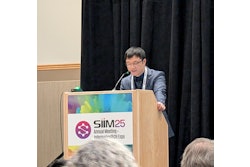The use of large language models (LLMs) with oncologic CT reports simplifies medical text and makes the reports clearer for patients -- but radiologist oversight is still necessary, according to research published November 18 in Radiology.
The study suggests that "LLMs can serve as effective preprocessing tools provided that expert review mechanisms are maintained," wrote a team led by Philipp Prucker, MD, of Technical University of Munich in Germany.
Patient comprehension of their health data is "key to empowering them for health care decision-making and informed consent," and "poor health literacy is associated with increased mortality in individuals with cancer, highlighting the clinical importance of effective medical communication," the group noted. In the U.S., the average adult reading level is eighth grade, but radiology reports are written with "complex medical terminology, which creates substantial comprehension barriers for patients," it wrote.
Large language models (LLMs) could help address the problem, but studies evaluating the impact of LLM simplification on patients' comprehension of radiology reports are lacking, Prucker and colleagues noted. To this end, the team conducted a study that investigated whether LLM-based simplification of oncologic CT reports would improve patients' text comprehension, perception of results, and reading time. The research included 200 adults with cancer (mean age, 64 years) who underwent routine CT restaging between April and May 2025. One hundred study participants received standard CT reports and 100 received LLM-simplified versions (created using Meta's Llama 3.3 70B and reviewed by radiologists).
The study's primary outcome was patient-reported scores using a seven-point Likert scale to rate cognitive workload, text comprehension, and report perception, among other factors; the team also tracked patients' report reading time. Secondary outcomes included readability metrics and independent radiologist assessments of report errors, usefulness, and quality.
Prucker's group found that the LLM-simplified reports reduced patients' median reading time from seven minutes to two minutes (p < 0.001). The simplified reports improved readability as well, with a mean Flesch-Kincaid Grade Level score of 8.89 compared to 13.69 for the regular reports (p < 0.001). (Higher Flesch-Kincaid Grade Level scores indicate a higher grade level and thus more complex text; a score of seven to eight is considered effective for public communication).
The team also reported the following:
Adjusted odds ratios for the intervention group compared to the control group* | |
Measure (in odds ratios) | Odds ratio (with 1 as reference) |
| Clarity | 20.6 |
| Cognitive workload | 0.2 |
| Perception of report usefulness | 5.5 |
| Readability | 42.2 |
| Text comprehension | 13.3 |
| *All results, p < 0.001 | |
 Chest CT images in a participant with metastatic nonseminoma, with relevant text from the original and simplified reports below each image (see Table S8 for the full reports). (A) Axial image shows pericardial effusion (*). (B) Axial images from a previous examination (left) and the current examination (right) show regressing pulmonary metastasis (arrow). (C) Coronal image shows right prepectoral port catheter with the tip in the superior vena cava (SVC) (†). This example does not contain errors in the text presented.Images and caption courtesy of the RSNA.
Chest CT images in a participant with metastatic nonseminoma, with relevant text from the original and simplified reports below each image (see Table S8 for the full reports). (A) Axial image shows pericardial effusion (*). (B) Axial images from a previous examination (left) and the current examination (right) show regressing pulmonary metastasis (arrow). (C) Coronal image shows right prepectoral port catheter with the tip in the superior vena cava (SVC) (†). This example does not contain errors in the text presented.Images and caption courtesy of the RSNA.
Finally, the researchers found that the radiologist review identified factual errors in 6% of the LLM-simplified reports, content omissions in 7%, and inappropriate additions in 3%.
The study results "support the use of artificial intelligence–assisted patient communication in radiology while emphasizing the critical importance of maintaining physician oversight to ensure patient safety and clinical accuracy," the authors concluded, noting that "future research should examine whether improved comprehension translates into greater patient engagement and improved health outcomes."
Read the full study here.




















